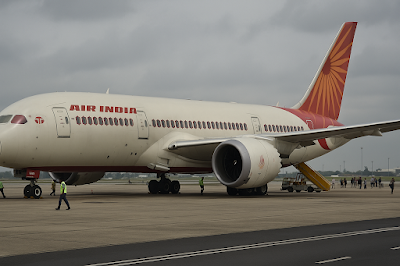Rcent Air India Issues
Following the June 12 incident, between June 12–19, over 83 domestic and international flights were canceled. Here are some key problems:
- A Delhi–Paris flight was canceled during pre-flight checks.
- An Ahmedabad–London flight was canceled due to aircraft unavailability.
- A San Francisco–Mumbai flight made an emergency stop in Kolkata due to a technical glitch, forcing Mumbai-bound passengers to disembark early.
- A Dubai–India flight faced a delay with a non-functional air conditioner.
- A Bangalore–Delhi flight made an emergency landing after an engine shut down mid-air.
- Toronto–Delhi and Chicago–Delhi flights were diverted or returned due to overfilled toilets.
- Prominent passengers like Shivraj Singh Chouhan and David Warner faced issues like broken seats and pilot unavailability.
- Celebrities like Sanjeev Kapoor criticized food quality and poor onboard service.
🛫 Air India’s History and Government Control
- Founded in 1929 by J.R.D. Tata, Air India started with a small mail aircraft worth ₹2,000.
- Passenger services began at ₹50/ticket, earning ₹10,000 in its first year.
- In 1948, the first international flight (Mumbai–London) took off.
- In 1953, the Nehru government nationalized Air India.
- J.R.D. Tata remained on board to help run it efficiently, splitting the airline into Indian Airlines (domestic) and Air India (international).
- In 1978, he was removed from the board by Morarji Desai’s government, starting a decline under bureaucratic control.
⚠️ Decline Under Government Control
- In 1992, despite a ₹333 crore profit and ₹2,000 crore reserves, the airline struggled when competition emerged.
- The 2007 merger with Indian Airlines turned disastrous—losses rose from ₹770 crore to ₹7,000 crore by 2009.
- Employee count was excessively high (256 per aircraft—double the global average).
- Salaries consumed 20% of revenue (vs. 10% in private airlines).
- Lack of accountability and job security led to poor service.
- Free tickets for staff and officials increased the burden.
- Outdated aircraft, broken seats, poor interiors, and no upgrades.
- A massive aircraft order worth ₹67,000 crore was made without enough routes or pilots.
- Air India bought several Boeing aircraft despite the manufacturer facing serious global quality concerns.
🛠 Boeing’s Quality Crisis
- Over 1,000 complaints in the past 10 years: engine fires, cabin smoke, doors detaching, landing gear failures.
- Loose screws led to mid-flight issues.
- Airlines like IndiGo moved towards Airbus, but Air India remained Boeing’s major buyer in India.
- A former Boeing quality manager flagged 11 faulty aircraft—6 purchased by Air India.
- Boeing’s image, once tied to NASA and WWII bombers, is now marred by safety concerns.
💼 Tata Group’s Acquisition and Revival Plan
Due to ₹85,000 crore in losses, the Indian government decided to sell Air India.
- In 2021, Tata Group reacquired the airline for ₹18,000 crore—₹15,300 crore in debt assumption and ₹2,700 crore in payment.
- Condition: No staff layoffs for 1 year; after that, only via Voluntary Retirement Scheme (VRS).
- In January 2022, Tata took control and launched a 5-year revival plan.
Key Plans:
- Massive Fleet Expansion: 470 aircraft ordered.
- Cabin Refurbishment: Old aircraft to be re-equipped with new seats, covers, and entertainment.
- Tech Upgrades: ₹1,500 crore invested in IT systems and service improvements.
- Domestic Market Focus: Merging Vistara into Air India and AirAsia into Air India Express to challenge IndiGo.
- Staff Restructuring: Offering VRS to older employees (1,500 given), hiring new talent.
🧩 Challenges in Revival
- New aircraft delivery will take 3–7 years.
- Refurbishment delays: 20–25 days per plane, due to long-overdue maintenance.
- Staff mindset is still rooted in bureaucracy—40% retain the old work culture.
- Speaking about faults is discouraged; two employees were fired for raising Boeing issues.
- Customer service lags, check-ins and responses are slow and inefficient.
- Toilet issues persist due to staff neglect, poor maintenance (blocked suction pipes), and passenger misuse (diapers, underwear in toilets).
Note: Many Air India staff claim Indian passengers behave worse on Indian flights than on foreign airlines.
🌅 The Road Ahead: Can Tata Turn It Around?
- Tata Group has the capacity and legacy to revive Air India without taxpayer burden.
- In 3 years, they’ve:
- Increased revenue by 25%
- Reduced losses by 50%
- Improved market share
- Enhanced on-time performance from 70% to 90%
Yet, delays and cancellations may persist until:
- All new aircraft are delivered
- Older planes are upgraded
- Staff attitudes evolve
Tata’s experience with brands like Taj Hotels could improve training and customer focus.
🛫 Final Thoughts
Reviving Air India is not just a business challenge—it’s about rebuilding trust, infrastructure, and culture. The journey may take 4–5 years, but with consistency, Air India could rise again as a symbol of Indian excellence in the skies.



Social Plugin